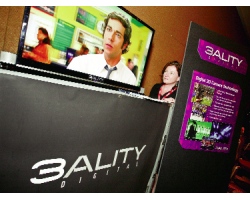With feature films in 3D gaining a strong foothold in theaters, entertainment companies and consumer electronic manufacturers now eye bringing the same technology into the home. At the recent 3D Entertainment Summit in Universal City, attendees had plenty of opportunities to check out what Sony, Technicolor, Sensio and Nvidia have to offer. Elsewhere at the summit industry insiders, entrepreneurs, and analysts discussed developments in 3D content creation and distribution illustrated by clips of recent films. John Lowry, whose Burbank company TrioScopics LP develops a color encoding system to turn two-dimensional content into three dimensions, faced a critical audience when touting the benefits of what the company has to offer during a lunchtime presentation. That’s because, Lowry said, entertainment industry professionals have a negative view of the anaglyph format his system creates. “It is like a four letter word with eight letters,” said Lowry, a serial entrepreneur whose other company restores old and damaged film. But Lowry hopes to make the case for anaglyph – which uses glasses with green and magenta lenses – as the format on which to view 3D content at home. TrioScopics has used its process for viewing at home the films “Journey to the Center of the Earth,” “My Bloody Valentine,” and “Coraline” resulting in a combined order of nearly 50 million pairs of glasses. When the DreamWorks Animation film “Monsters vs. Aliens” comes out on DVD this month it will include a 15-minute bonus, “Bob’s Big Break” also using the TrioScopics process. “‘Bob’s Big Break’ will surprise (the skeptics),” Lowry said. “This is going to knock their socks off when they see this in 3D.” As popular as 3D feature films are proving to be, widespread adoption in the home is still years away. Content providers are still feeling out what can be done with the technology and how best to use it. So far, sporting events – football and basketball games – have proven popular in the 3D format. A 2008 survey of 1,000 people by the Entertainment Technology Center at USC found that 17 percent would watch 3D at home. A survey by marketing firm In-Stat found that the more familiar people were with 3D in theaters or who owned a Blu-ray player the more likely they were interested in watching 3D content at home. In other parts of the world, television networks have dedicated channels for 3D programming. Sky Television in England, for instance, will launch its channel next year with movies, entertainment and sports. “They (the U.S. networks) are checking it out,” said Marty Shindler, an entertainment industry consultant who has moderated panels on 3D. “They are trying to figure what logistics they need to have; what are the problems they will encounter. You just don’t get up in the morning and do a 3D TV show.” In February, the NBC series “Chuck” became the first ever to broadcast a full episode in 3D. The cameras used were developed by 3ality Digital Systems in Burbank, the same firm behind the 3D U2 concert film, and NFL and college football games broadcast to movie theaters in 3D. 3ality founder and CEO Steve Schklair called the shoot a “proving ground” to show that a 3D television show could be done under tight time constraints. While the episode cost more than typical because two 16mm cameras had to be traded out for two 3ality cameras, it was a good experience that turned out the biggest audience ever for the series, Schklair said. Since then, other networks have contacted the company namely to find out the cost of doing a show in 3D, Schklair added. (NBC spokesman Curt King refused to make a network executive available to talk about the “Chuck” episode.) What will drive home adaption of 3D is up in the air. Sporting events and video games are popular responses to that question. Schklair thinks it will be packaged content – feature films released on the 3D version of Blu-ray discs expected to be made available as early as 2010. That is the same timeline that Sony and Panasonic will begin to sell large-screen high definition televisions with 3D capability. The Walt Disney Co. is betting the high def discs will pave the way to home acceptance. “Blu-ray with its capacity and bit rate is the highest quality delivery,” said Benn Carr, vice president of technology for Walt Disney Studios. Lowry, however, thinks that the timeline to bring out the discs and the monitors on which to watch them is too long; that momentum will be lost between when a film proves popular in the theaters and when people may want to watch it at home. The TrioScopic system can be an intermediate step to bring 3D films to the home while the Blu-ray Disc Association works on the standards for a 3D version of the format, Lowry said. But there is still the stigma of the anaglyph format to get passed, which Lowry believes was solved during two years of development. “You don’t have to spend a nickel in new equipment,” Lowry said. “It works on any television display.”
